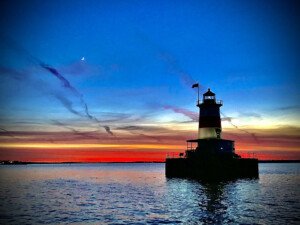Lighting the Way

Photograph by Pat Piasecki
It started as an afterschool job handcrafting copper weather vanes at Golden Eagle, a small family business. Skip Heal, then 15, was good at the work, and liked it, too. After graduating from the University of New Hampshire in 1975, he returned to the company, perfecting his copper-working skills until, at age 33, he decided to launch his own company, Northeast Lantern.
Out of deference to his former employer, Heal avoided using copper, instead making his lanterns out of brass, which suited him just as well—maybe even better. Brass, he thought, had more potential. It was economical, malleable, didn’t rust, and was popular among customers. “It was just me, doing what I liked to do,” he says. “I thought I could build a better mousetrap. But I had no visions of where I wanted it to go.”

Clockwise from top, a worker applies a finish to a “Concord” fixture; wiring a wall sconce with a candelabra socket requires precision; the “Heal” and “Onion” fixtures are among Northeast Lantern’s most popular items. / Photographs by Pat Piasecki
Heal’s colonial-inspired, outdoor lighting fixtures, mostly made of weathered brass, began winning him loyal clients. But within a few years, custom requests brought Heal’s meticulous work indoors, where lighting needs to be more responsive to current trends. Customer demand for more contemporary looks, combined with changes in bulb design—from incandescent to fluorescent to LED—pushed Heal to constantly update his products. These days, he launches one new model each December at his modern workshop in Exeter, New Hampshire—two towns over from his Hampton Falls childhood home.
That’s where the company’s 45 employees handcraft each fixture using a process perfected by Heal. First, employees cut, roll, bend, and punch the sheet metal into various shapes. The resulting pieces are then soldered together and moved to the finishing room, where employees wash and clean the fixtures and apply the desired patina. Completed works are then wired for electricity, glassed (all glass is cut in-house), tested, and packed for shipment.

Prior to installing glass, a craftsman inspects the top of a fixture to ensure proper fitting / Photograph by Pat Piasecki
Heal says it’s a team operation, and it’s also a family operation. His two children, Jamie and Chris, both spent time on the factory floor as teens, and are now involved in day-to-day business—Chris as the vice president of operations and Jamie as the vice president of sales and marketing. “I think people working here are very happy,” Heal says. “Everyone eats in the same lunchroom, takes breaks together, and gets along—the process runs pretty smoothly.”
The brand’s most popular style is the undeniably New England “Onion” light, so-named for the shape of the glass, which is handblown in West Virginia. The company’s adaptability is also a big draw. “One of the things my clients like best about Northeast Lantern is that the pieces can be very custom,” says Lee McMath, co-owner of Delande Lighting in Salem, who has carried Northeast Lantern products since the brand’s debut. “If someone doesn’t have room for a scroll, or has a space that needs something more dramatic, Northeast Lantern can make it—and in any number of finishes—which is why it’s a favorite not just for more traditional homes but really very modern ones as well. We sell it day in and day out.”

A craftsman inspects an unfinished “Heal” fixture / Photograph by Pat Piasecki
While McMath’s patrons enjoy Northeast Lantern’s customizability, she says it’s the brand’s commitment to making sturdy products that make the fixtures so popular. People love the lifetime warranty, she says, something rarely offered in this business. “You don’t find that at all,” McMath says, “and it’s especially great for houses near the ocean. Everything holds up.”

Clockwise from left, the Exeter, New Hampshire, workshop boasts 21 soldering stations where craftspeople work individually and in teams; a fixture is outfitted with glass panels that are cut in-house; finishes are hand-applied after the metal parts are cleaned / Photographs by Pat Piasecki
Products range in price from $200 to $2,000, and can be created in “whatever size the customer has a space for,” Heal says, noting that he’s made chandeliers as large as 5 feet in diameter. Custom requests often come in as rough sketches, and of the tens of thousands he’s made, a recent standout was an all-brass chandelier fashioned in the shape of a sailboat. From its base hang four pendant lights attached to a weather vane—a poetic, if unintentional, nod to Heal’s roots. “That one,” he says, “was pretty cool to make.”

When constructing new fixtures, workers trace these brass and copper templates to ensure product consistency / Photograph by Pat Piasecki


